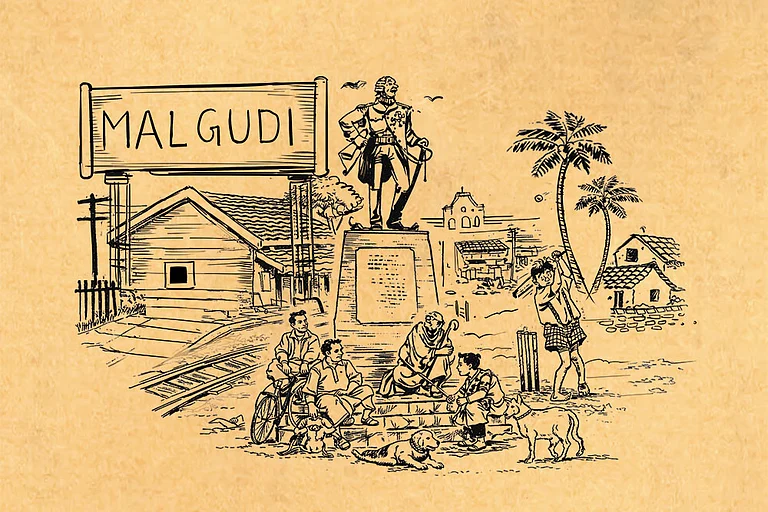For centuries India knew only the bullock cart. People sat hunched within its wooden frame jostling from side to side, slowly inching their way up the road. The ancient bulls snorted, progress was slow. Then came technology, the Birlas and the Hindustan Ambassador. People sat hunched within a metal frame, jostling from side to side. The wheel creaked, the engine snorted. It was not so different from the bullock cart, but in the ‘50s and ‘60s it was India’s own symbol of a fast, fuel-efficient urban transport.
Under the title ‘Old cars never die, they only move to India’, an article appeared not so long ago, in the Automotive Digest in England. Its cynical message hurt, because it hit the truth. The bullock cart was after all, an Ambassador with the leathery hide of an animal, the Ambassador, the reluctant animal duplicated in steel. When it was weary after that long hot ride to the neighbour’s house its bald tyres were removed from the rims, so the body could regain its balance under the cool shade of a leafy tamarind tree. At tea time, a gallon or two of Mobil 307 was poured down her parched metal throat, then the driver talked to it, sometimes read it a short story from John Kenneth Galbraith’s An Ambassador’s Journal. After some time, the radiator snorted in an affectionate sort of way, and the gears jammed. And before you know it, the car was a slave for the rest of its life. Just like the family bullock. You washed it daily in the greenish slime of the village tank or hosed it on the driveway; checked its gums or peered down the radiator, knowing there was little difference between the two. No difference of speed or vintage or comfort. Not even a difference of skin colour. Both served you like no human being ever did. Of course, in the ‘70s when its time was over, the mechanical beast was put out of its misery, with just a quick and painless bullet in the radiator. The bullock cart lived on.
A Chandigarh to Manali video coach with 57 aboard plunged down a 300-foot rocky gorge and smashed against the rocks in the river-bed. When rescue teams arrived at the scene of the accident the passengers were angry at this intrusion and felt that the team could have waited till after the completion of Dil Diya Dard Liya before carrying their mangled bodies out into the ambulance.
The video age had dawned and Indira Gandhi and her son had a dream for a better India. It was a rare vision that saw ‘a roti on every tava and a bullock cart in every garage’. Just when All India Radio had officially declared a drought in the country, and the Lok Sabha was discussing subsidised air travel for MPs, when the India International Centre was holding seminars on ‘Famine and the Socialist State’, Sanjay Gandhi decided to build an indigenous car. At a difficult economic juncture in the nation, the idea of a nice, foreign-looking car-faster than the Ambassador, more spacious than the bullock cart-appealed to everyone’s sensibility. To a nation burdened with families, deficits and communal violence, what could be better than a spiffy, low-slung automobile to take people’s mind off things. And launch India symbolically out of its bullock cart century.
And things were bound to change. Fashioning an aggressive American consumer economy out of a rural socialist one was easy: in a place where the farmer lived in benign satisfaction for centuries, where city roads were quiet, broad and tree-lined, new objects suddenly appeared on the horizon; and the country was quickly overrun by packets of instant noodles, freeze-dried chips, plastic mineral water bottles and red and blue Japanese cars.The bullock cart was still there but stacked with Kelvinator fridges, TV cartons and other symbols of economic progress. And that wasn’t all. Packages of economic reforms were handed out like malaria pills in an epidemic; employment schemes allowed even the poorest to set up small-scale units for synthetic food and to reuse nuclear waste in jams and achars. Contaminated foreign wheat was distributed to the villagers, just so farmers could diversify into liquor vending and gambling. Prostitutes also received government subsidies to set up operations in sexually-deprived areas. In the evening, everyone watched Doordarshan Live to get a brief outline of prime minister Indira Gandhi’s schedule for the day, what she said, what statement she issued, what she had for lunch, how many times she belched; and indeed, what international conference she inaugurated.
Foreign Briefs: A pair of foreign briefs was found in the conference hall at Vigyan Bhavan, where a high-level meeting of the foreign ministers of South Afro-Asian Nations whose names begin with the letter M was held. Although the meeting was progressing well, many of the same nations were not: Madagascar’s economy was down; in the Maldives, tourism was down; Mauritius was just feeling rundown. Understandably, spirits in the conference hall were low. It was only when a delegate from Mozambique spotted the pair of briefs that things began to look up. The colourful briefs with a strange sideways cut were carefully examined by a high-level representative of each nation before being returned to the President...
In the ‘80s and ‘90s, it doesn’t take global conferences or the Parliament to make India a setting of daily satire and parody. With the exception of Somalia, Kosovo-and maybe now East Timor-India has become one of the funniest places on earth. For where else would you find the largest number of forest management and research institutes than in a country where 20,000 hectares of wilderness are eroded every day; where else would you find a minister for railways extending the national network to include his remote village; where would you find six grown men with doctoral degrees sitting together in a train compartment and conducting a deep, heartfelt, intellectually stimulating debate on the shunting schedule of the 242 Down passenger train from Mehsana, a widely acclaimed book, Trains at a Glance, in hand? Where else but India would you find innovative uses for ordinary items like kerosene oil and nylon saris?
In a reversal of roles, in a touch of bizarre irony along with a tragic twist of fate, a newly-married chartered accountant was burnt to death when the nylon sari he was carrying for his wife Saroj, a homely girl from a Hindustan Times matrimonial ad, caught fire. In a frantic bid to make the most of the situation, the eager husband tried to talk Saroj into wearing the burning garment, or at least trying it on. Unfortunately, he himself was overcome by the flames and succumbed to third-degree burns at the Germanine Grief Memorial Hospital.
India allows everything to co-exist: burnt wives and active feminism, mineral water and cholera, the personal computer and the hand plough, lesbianism and arranged marriages, the Ambassador and the Maruti. Everything is acceptable. Caste and equality go hand in hand; untouchables are persecuted but are also free citizens in society. Western concepts are absorbed and mingle freely with Indian ideas. A traditional marriage is video-taped and played back for the guests. A website on the Internet provides free advice on international agricultural practices to landless farmers. Contradiction is the only way, the Indian way.
If you look around, there’re enough civic signs of healthy tolerance. There is an Islamic tomb in every old neighbourhood of the city; a Hindu temple is quietly being ‘regularised’ down the road: a delegation of Buddhist monks is attending a peace conference at the India International Centre. The day-to-day signals are those of a country tolerant in mind, where an unwritten code of religious and social conduct governs the passing of each day. But the passive individual, given to the rituals of secularism in his own life, becomes rapidly fanatical when part of the larger collective of his own community.
Savage riots broke out between Hindus and Muslims in Calcutta. The rioting started in the southern, fashionable section of town between members of the same family. Lokesh Anand, a Hindu, was playing bridge in the den with his brother-in-law Muhammad Latif, a Muslim, when the two began to accuse each other of doctoring the cards. Word of the discord spread like wildfire throughout the apartment and soon fighting flared amongst all the family members. Hindu members barricaded themselves into the kitchen. Armed with steak knives, they attacked the Muslims cowering under the dining table. A savage battle raged during the day; the Muslims destroyed the statue of Kali in the Puja room; the Hindus burnt the last chapter of the family Koran, so the in-laws couldn’t find out how the story ended. By evening, everything had been destroyed.
Isn’t intolerance a small price to pay for secularism? I’m all for an open, casteless, non-sexist, non-racist society, as long as it leaves me alone. The good thing is that the Indian city, caught up in the drive for variety, has already created happily separate enclaves. A married, orthodox, Bengali Muslim CA with two kids, who owns a car and life insurance and works in a multinational company, is not likely to live next to a South Indian lesbian couple with an adopted Sikkimese baby. It is a much safer bet living with a neighbour who is racially, morally, sexually, spiritually and economically your equal than attempting to savour the uncertain benefits of diversity.
A 36-year-old widow, Punjabi Kshatriya Dogra, with a wheatish complexion and two children of light to semi-light complexion, seeks matrimonial alliance with a 36-year-old widower, also Punjabi Kshatriya, wheatish complexion, with two children of light complexion. Caste and colour no bar.
Diversity is best practised behind closed doors, in the air-conditioned confinement of a seminar on communal harmony. The symbolic act is more important than any realistic accomplishment. It’s more important to show that you care than actually care. A conference on national integration is always more popular than national integration.
The final item in the newspaper:
Missing: 52-year-old M.K. Gandhi, balding, wheatish complexion, wearing only a loin cloth and a toothless smile, has been missing for the past 51 years. Last spotted weaving cloth in a low mud-and-cowdung house somewhere in central India. He’s precocious, self-absorbed, fiercely independent and has solutions for rural illiteracy, urban poverty, backwardness and all social and religious ills of this country. The man carries a stick but is harmless and will answer to the name of Bapu. Anyone giving information on his whereabouts will be duly rewarded. Bapu, if you are reading this-please come home, all is forgiven, all is forgotten.Mother serious, the country even more so.






















